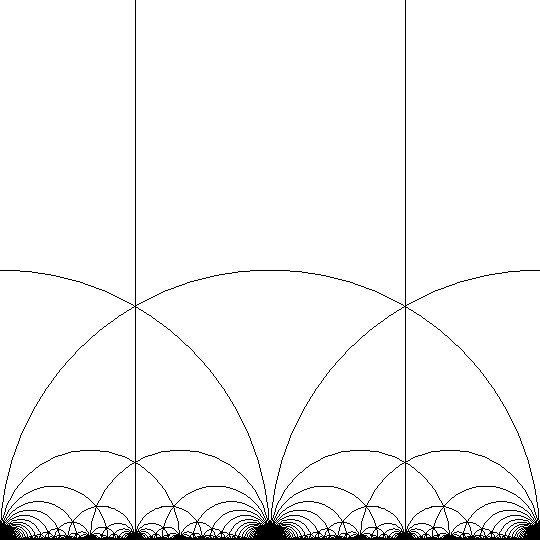
|
Introduction to Modular Forms, Summer Term 2022Dr hab. Masha VlasenkoModular forms belong to the most advanced tools of modern arithmetic. First examples were discovered back in XIX century. These are holomorphic functions on the complex plane that, quoting Barry Mazur, "satisfy so many internal symmetries that their mere existence seem like accidents". Such functions appear to be useful in combinatorics (e.g. for studying properties of partition functions), number theory (to prove Fermat's Last Theorem) and other areas of mathematics and theoretical physics (e.g. Monstrous moonshine, sphere packing in higher dimensions, quantum field theory). Modular or, more generally, automorphic forms are key objects in the Langlands Program, a metahypothesis that shapes current development of arithmetic algebraic geometry. Our course is a handy introduction to this theory. During problem sessions students will work on key examples and learn to apply modular forms to various questions. Here is a presentation of this course in Polish. Time: Tuesday, 14:15-16:00 (lecture) 16:15-18:00 (tutorial) starting from March 1 Spring break: April 14-19 Venue: 5870, Faculty of Mathematics of the University of Warsaw, Banacha 2 Assessment: 40 % continuous assessment (tutorial work and written homework), 60 % final exam + extra points for solving the projects. Final exam: Friday, June 24 from 2 to 6 pm in room 2100 at Banacha 2 |
I. Definitions and first examples
- Definition of modular forms and construction of a fundamental domain for the modular group
- First examples: Eisenstein series and their Fourier coefficients Assignment 1 (tutorial on March 8, homework due on March 15)
- Finiteness of dimensions of the spaces of modular forms
- The discriminant function Assignment 2 (tutorial on March 15, homework due on March 22)
- Algebra of modular forms
- Modular invariant j Assignment 3 (tutorial on March 22, homework due on March 29)
II. Modular forms for congruence subgroups
- Analysis on compact Riemann surfaces: Riemann -- Hurwitz formula Assignment 4 (tutorial on March 29, homework due on April 5)
- Congruence subgroups, fundamental domains and quotients Appendix 1: Classification of linear fractional transformations
- Analysis on compact Riemann surfaces: Riemann -- Roch theorem Assignment 6 (tutorial on April 12, homework due on April 26)
- Modular forms and dimension formulas Assignment 7 (tutorial on April 26, homework due on May 10)
- Further examples: theta series Assignment 8 (tutorial on May 10, homework due on May 17)
Appendix 2: Elliptic points and ramification
Assignment 5 (tutorial on April 5, homework due on April 12)
Appendix 3: Eisenstein series with characters
hints for Assignment 8
III. Moduli of elliptic curves
- Complex tori and elliptic functions Assignment 9 (tutorial on May 17, homework due on May 24)
- Elliptic curves and their moduli Appendix 4: Plane curves
Bonus: my two old lectures on the theory of complex multiplication [1][2]
Assignment 10 (tutorial on May 24, homework due on May 31)
Appendix 5: Families of elliptic curves
IV. Arithmetic aspects
- Hecke operators on lattices and modular forms Assignment 11 (tutorial on May 31, homework due on June 7)
- Petersson product and Hecke eigenforms
- L-series Assignment 12 (tutorial on June 7, homework due on June 14)
- Modularity of elliptic curves and Fermat's Last Theorem (an overview)
Software and tables
PARI/GP (an advanced calculator programmed by number theorists)Magma (have a look at the online calculator and Handbook's section on modular arithmetic geometry)
LMFDB (a database of modular forms and L-functions)
Literature
- [Serre]
- J.-P. Serre, A Course in Arithmetic, Chapter VII
- [1-2-3]
- The 1-2-3 of Modular Forms, Elliptic Modular Forms and Their Applications by D.Zagier
- [Zagier]
- From Number Theory to Physics, Introduction to Modular Forms by D.Zagier
- [Milne]
- J.S. Milne, Modular Functions and Modular Forms
- [DiamondShurman]
- F. Diamond, J. Shurman, A First Course in Modular Forms
- [Lang]
- S. Lang, Introduction to Modular Forms
- [PanchishkinManin]
- Yu.I.Manin, A.A.Panchishkin, Introduction to Number Theory, Part II: Ideas and Theories, Chapters 6 and 7